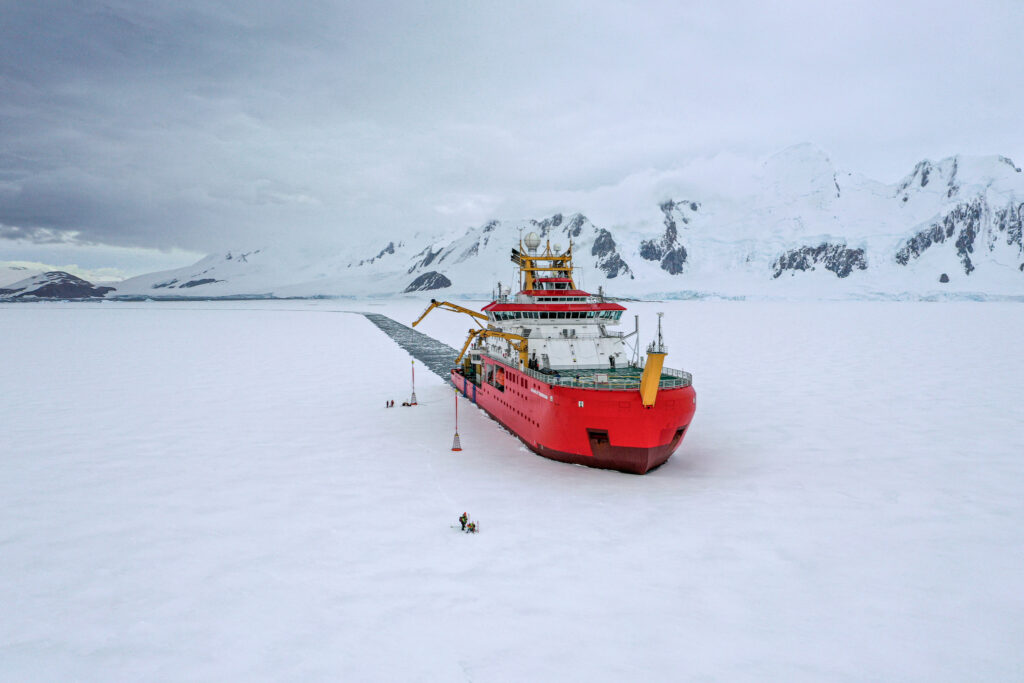The UK’s newest icebreaking research vessel the RRS Sir David Attenborough has completed its initial ice trials during its maiden voyage to Antarctica – a critical milestone in the commissioning of the new polar ship.
The trials team tested the ship’s capability over 10 days in January by following a set of standard procedures to ensure the ship fulfils its contractual specifications to perform in ice. British Antarctic Survey (BAS) operates the RRS Sir David Attenborough, which is owned by UKRI-NERC (UK Research and Innovation-Natural Environment Research Council).
The ship was tested through ice, at every power level, to measure its performance and compare it to the expected, modeled results. The team also performed a range of other maneuvers including reversing, turning, as well as impact tests at different speeds in areas of sea ice around the Antarctic Peninsula and Bellingshausen Sea.
The team enlisted the help of satellites to locate suitable areas of ice for the trials. Most maneuvers took place in fast ice – ice that is attached to the coast and not moving. This allowed the team to calculate accurately the amount of energy required to break the ice. Tests in various ice conditions and concentrations, such as open and closed pack ice, give a complete picture of the ship’s performance.
To fully understand the ship’s performance, the trials team took measurements of the ice, including ice thickness and the amount of snow, as well as physical properties of the ice such as temperature and salinity.
Ralph Stevens, captain of RRS Sir David Attenborough, BAS, said, “Overall, we’re really pleased with the ship’s performance in ice trials – in some trials it actually performed better than we expected. The trials did highlight some issues with the ship which need to be addressed but this was expected – the SDA is a bespoke ship with a complex design, and the purpose of trials is to find the things that don’t work so well.
“The thing that surprised us most was how comfortable the ship was while breaking through the sea ice. The bow breaks the ice in a completely different way to our previous vessels and is much quieter than expected,” he said.
The ship encountered unprecedented sea ice conditions after the ice trials – second-year sea ice, covered in a thick 1.5m layer of snow. This hampered efforts to reach Stange Sound to deliver critical science cargo in support of the International Thwaites Glacier Collaboration.
The RRS Sir David Attenborough is a Polar Ice Class 5 (PC5) ship, meaning it can operate year-round in medium, first-year ice. The ship can break through ice 1m thick at a speed of 3kts (5.6km/h). When it is ice breaking, the ship rises up on the ice and uses its weight – 15,000 tons – to break through.
This multidisciplinary research platform will transform how ship-based science is conducted in the Polar Regions, and provide scientists with state-of-the-art facilities to research the oceans, seafloor, ice and atmosphere.
The ship’s sensitive acoustic instruments are housed within the hull and covered with a protective material to ensure they are protected when the ship is in ice. Other instruments, such as the farsounder forward-looking sonar, which warns of navigational hazards under the water (such as unchartered rocks), is fitted on a retractable pole and will only be deployed when the ship is not icebreaking. The ship also has a moon pool – a 4x4m hole through the middle of the ship – through which researchers can deploy instruments, even when in ice.
The RRS Sir David Attenborough will return to the UK in June 2022 at the end of the Antarctic season. The ship will spend several weeks in refit to rectify the issues identified during ice trials, and to finish commissioning science equipment, which was delayed due to Covid-19. The ship will also spend around 30 days at sea conducting initial science trials, testing acoustic and winch equipment. These trials are to ensure all the complex science equipment on board the ship is functioning correctly and will provide the crew and science teams the opportunity to establish new protocols and ways of working. Further science trials will take place during the 2022/23 Antarctic season.



